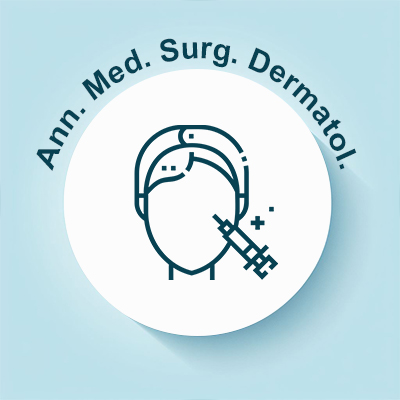
Annals of Medical and Surgical Dermatology
OPEN ACCESS
ISSN: 3048-5185

OPEN ACCESS
ISSN: 3048-5185
Acne vulgaris is a common dermatological condition with multifactorial origins, including hormonal and seditious factors. Recent studies suggest a implicit link between acne and insulin resistance (IR), a condition constantly associated with metabolic pattern. This review explores the pathophysiological mechanisms connecting insulin resistance to acne development. Elevated insulin situations, frequently a result of insulin resistance, can increase androgen product, leading to increased sebaceous gland exertion and sebum product, crucial factors in acne conformation. also, insulin resistance may contribute to systemic inflammation, aggravating acne symptoms. Epidemiological studies and clinical trials have shown a correlation between insulin resistance labels and acne inflexibility, particularly in individualities with metabolic pattern. Therapeutically, addressing insulin resistance through salutary interventions, pharmacological treatments like metformin, and life variations may help ameliorate both conditions. This review highlights the significance of considering metabolic health in acne operation and discusses unborn exploration directions to more understand this connection and optimize treatment strategies.
Fungal infections have become a decreasingly current public health concern, with the rise of antifungal resistance posing significant challenges to effective treatment. The mechanisms of fungal resistance are multifaceted, involving inheritable mutations, efflux pump overexpression, altered medicine targets, and biofilm conformation. These factors, combined with a limited number of effective antifungal agents, particularly for resistant strains, complicate treatment rules and lead to poor clinical issues. also, individual limitations, delayed remedy, and side goods of antifungal medicines further complicate the issue. To optimize antifungal treatments, strategies similar as combination remedy, antifungal stewardship programs, and substantiated drug are pivotal in prostrating resistance. Arising antifungal agents, including new medicine classes, nanotechnology- grounded phrasings, and immunotherapy, offer promising druthers to combat resistant fungal pathogens. This review explores the current challenges in antifungal remedy, evaluates implicit strategies for perfecting treatment issues, and discusses unborn directions in the development of new antifungal agents.
Recent developments in skin cancer treatment have brought significant advancements, particularly in the field of immunotherapy. One of the most promising approaches is the use of checkpoint impediments, similar as pembrolizumab and nivolumab. These specifics work by blocking proteins that help the vulnerable system from attacking cancer cells, allowing the body’s natural defenses to fete and destroy nasty growths. They've shown remarkable success in treating advanced carcinoma and other aggressive forms of skin cancer. In addition to immunotherapy, targeted curatives have also surfaced as an effective treatment option. These curatives concentrate on specific inheritable mutations set up in cancer cells, enabling largely precise treatment with smaller side goods compared to traditional chemotherapy. Another innovative approach is photodynamic remedy (PDT), which involves using a light-sensitive medicine that, when actuated by a specific wavelength of light, widely destroys cancerous cells while minimizing damage to healthy apkins. PDT is particularly useful for treating superficial skin cancers and precancerous lesions. Arising technologies similar as Tumor- Insinuating Lymphocyte (TIL) remedy offer new stopgap for cases with advanced carcinoma. This substantiated approach involves rooting vulnerable cells from a case’s excrescence, expanding them in a laboratory, and introducing them to enhance the body’s capability to fight cancer.
Skin infections remain a significant public health concern, with bacterial, fungal, and viral pathogens causing a range of dermatological conditions. This review explores the most common bacterial skin infections, including impetigo, cellulitis, and folliculitis, caused primarily by Staphylococcus aureus and Streptococcus pyogenes, and their treatment with antibiotics. Fungal infections, similar as tinea corporis, candidiasis, and seborrheic dermatitis, are bandied, pressing the part of dermatophytes, Candida species, and Malassezia in their pathogenesis and operation with antifungal curatives. Viral skin infections, including herpes simplex contagion (HSV), varicella- zoster contagion (VZV), and mortal papillomavirus (HPV), are also examined, with an emphasis on antiviral treatments and the part of vaccines. The review also addresses ultramodern challenges in the opinion and treatment of these infections, particularly the rise of antimicrobial resistance, and underscores the significance of early intervention and substantiated treatment approaches. Understanding these infections is critical for effective operation in the contemporary clinical setting.
Nutrition plays a fundamental role in maintaining skin health, influencing its appearance, integrity, and aging process. The skin, as the body’s largest organ, relies on essential nutrients to perform critical functions such as repair, protection, and regeneration. Various skin conditions, including acne, atopic dermatitis, premature aging, and UV damage, have been linked to dietary patterns and nutritional intake. Scientific studies have demonstrated that a well-balanced diet rich in vitamins, minerals, antioxidants, and healthy fats can significantly impact skin function and overall health. Vitamins such as A, C, and E play a key role in collagen production, skin hydration, and protection against oxidative stress. Omega-3 fatty acids, found in fish and nuts, have been shown to reduce inflammation and improve conditions like eczema and psoriasis. Zinc and selenium contribute to wound healing and acne management, while polyphenols from plant-based foods help protect against environmental damage. Additionally, the gut-skin connection has gained attention, with probiotics and a healthy microbiome being linked to reduced inflammation and improved skin barrier function. Nutrition also plays a critical role in immune-mediated skin conditions such as psoriasis, lupus, and vitiligo.
